The Abbey Art Collection
Seek Things Above
Providing a window into the art world of Mount Angel Abbey.
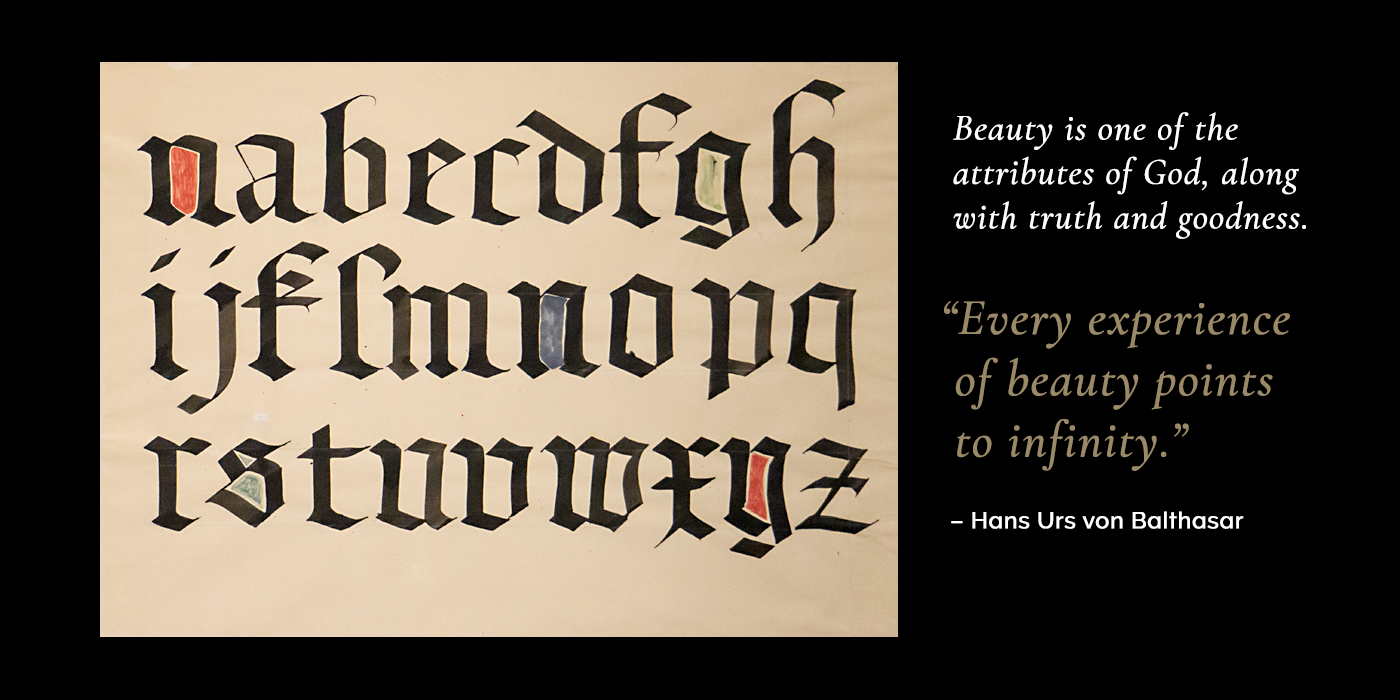
“Black Letter Exemplar” by Lloyd J. Reynolds. A gift from the artist c 1967 to Fr. Vincent Trujillo, O.S.B., 14.75” x 20.25” (Textura).
Monasteries
As the Western Roman Empire declined (376-476) and Europe entered what is now called the “Dark Ages,” monasteries preserved the calligraphic tradition.
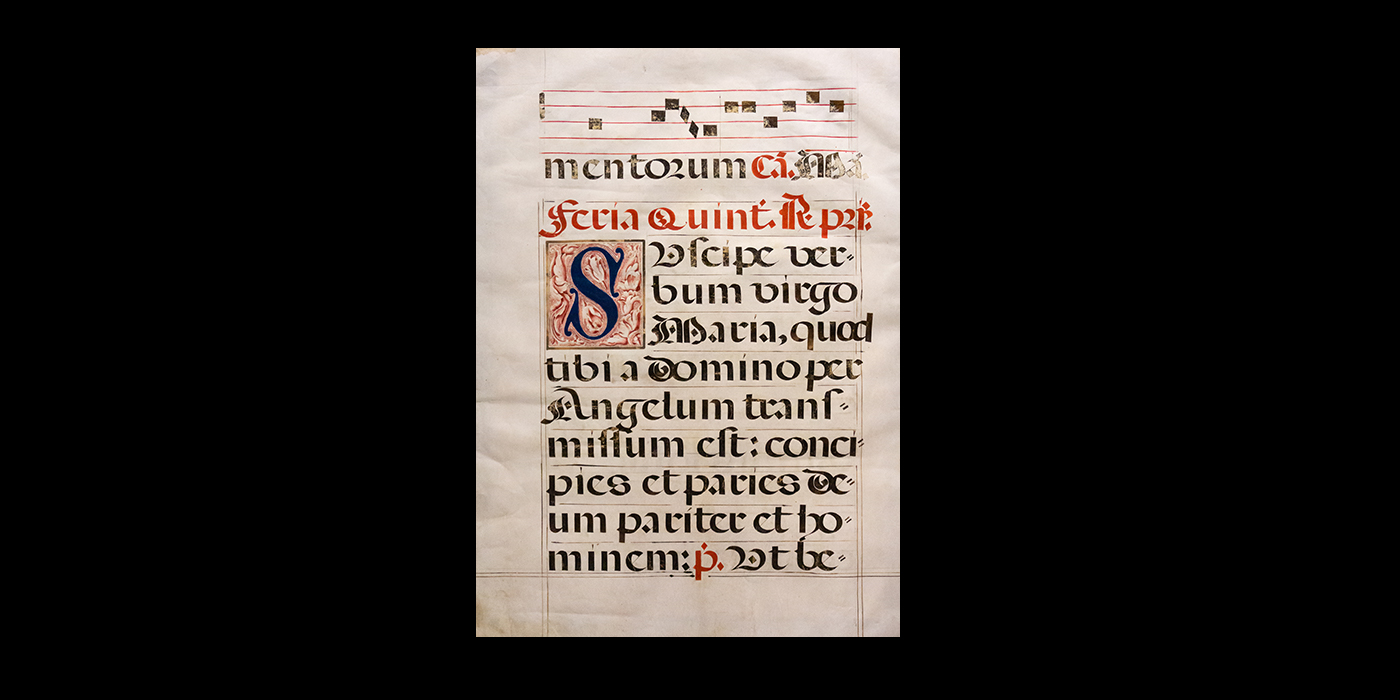
“Receive the Word, O Virgin Mary” By Unknown monk, 32.25” x 23.5” (Spanish Round Gothic).
Around the 8th century, monasteries gradually developed the minuscule style, a compact form of Uncial, more suitable for copying the Bible and other religious and secular texts.
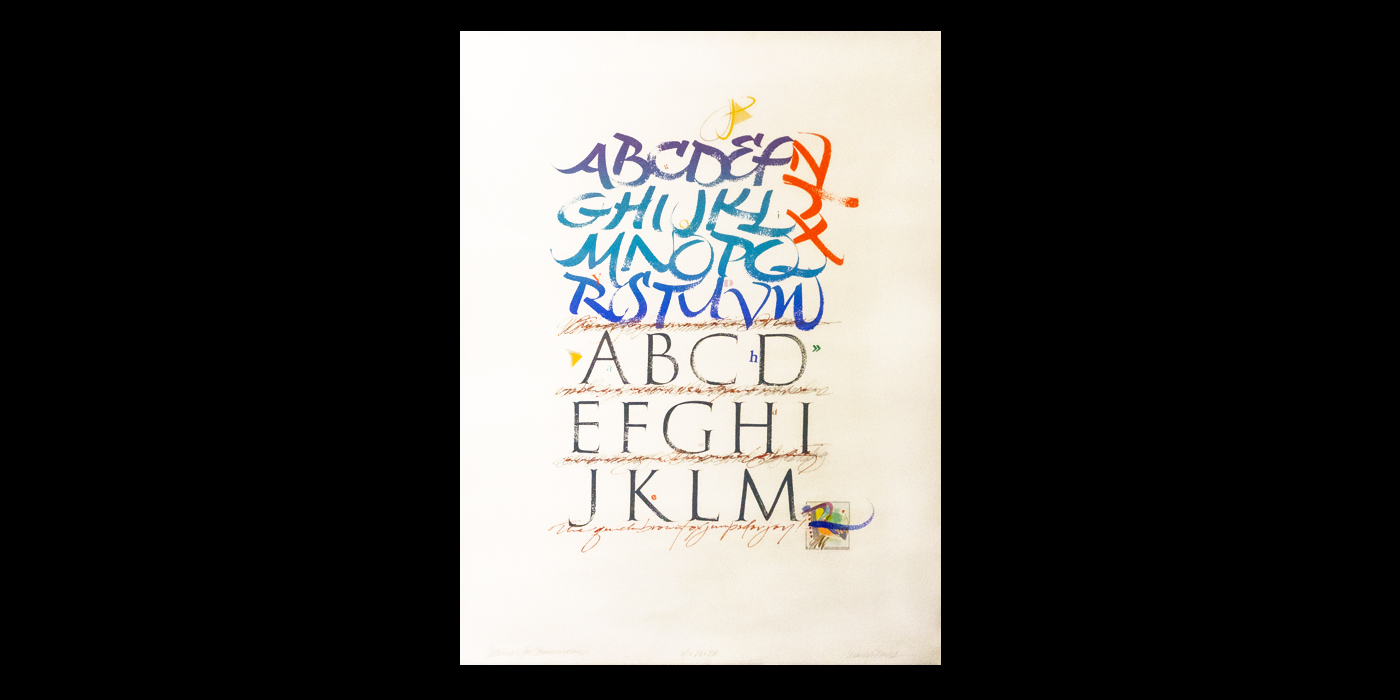
“Writing is for Communication” by Marilyn Reeves, 25.5” x 18” (Brush Lettering).
In medieval times, from the fall of Rome to the 15th century, sacred calligraphy developed some special features such as the illumination of the first letter of a text. Illuminations were designed to help the reader ponder the meaning of the text as well as inspire with their beauty.
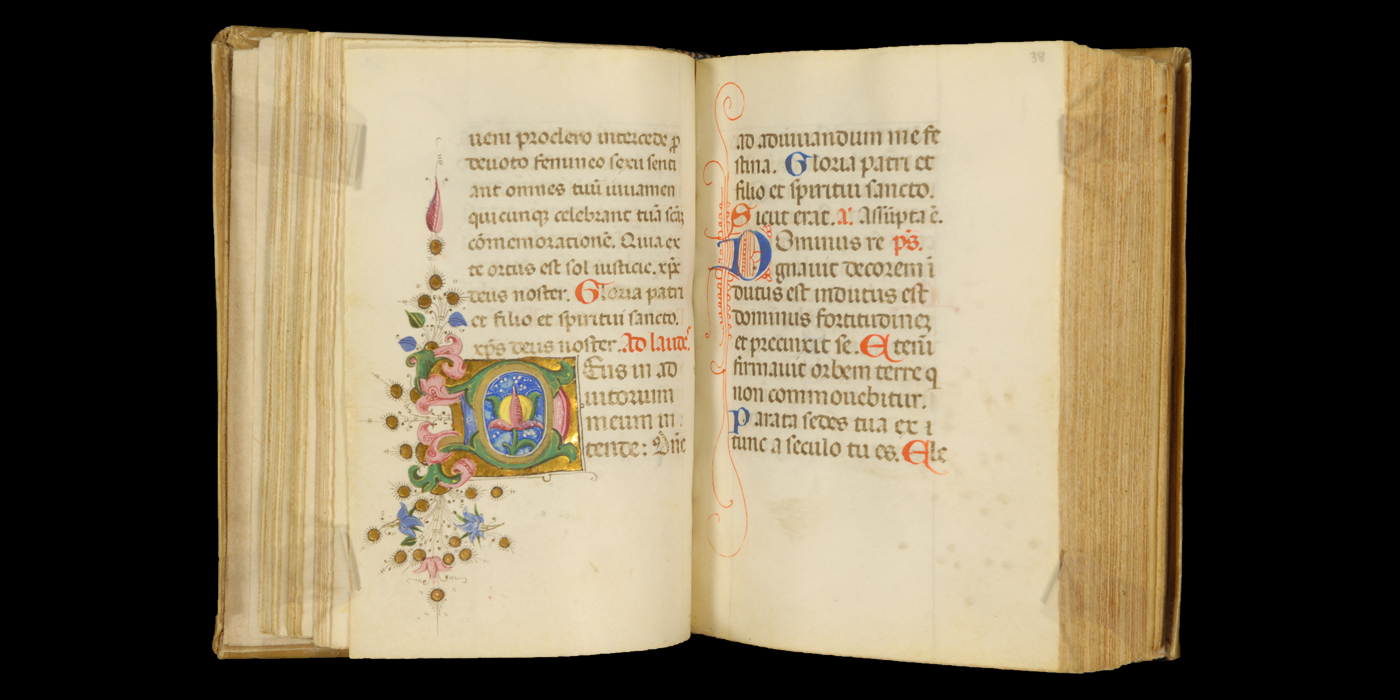
“Manuscript Illumination” by Unknown monk. 7” x 5.25” (Textura).
Printing Revolution
1455 saw the advent of the Gutenberg Bible. The typeface adopted by Johann Gutenberg was Textura, also referred to as Gothic, and based on the handwritten letterform used in religious works of the late-medieval period.
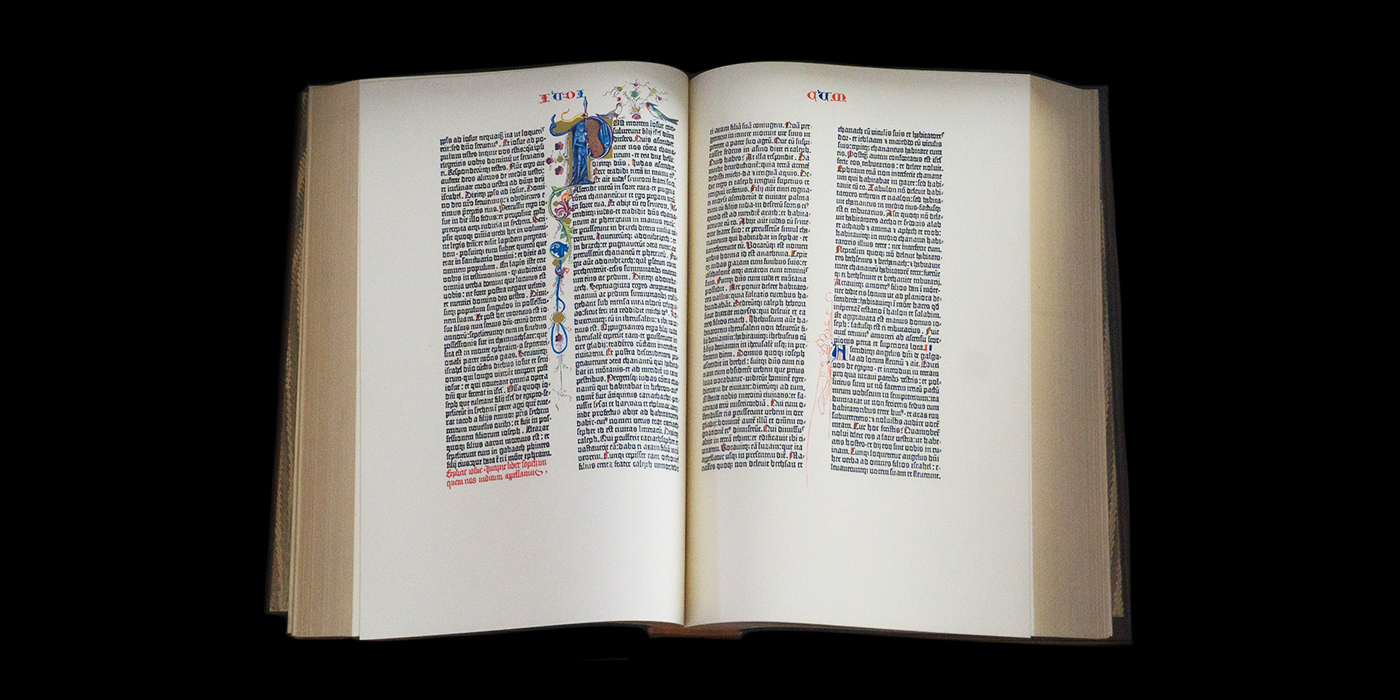
Facsimile of “Gutenberg Bible” by Johann Gutenberg. 5.5” x 6.5” (type based on Textura).
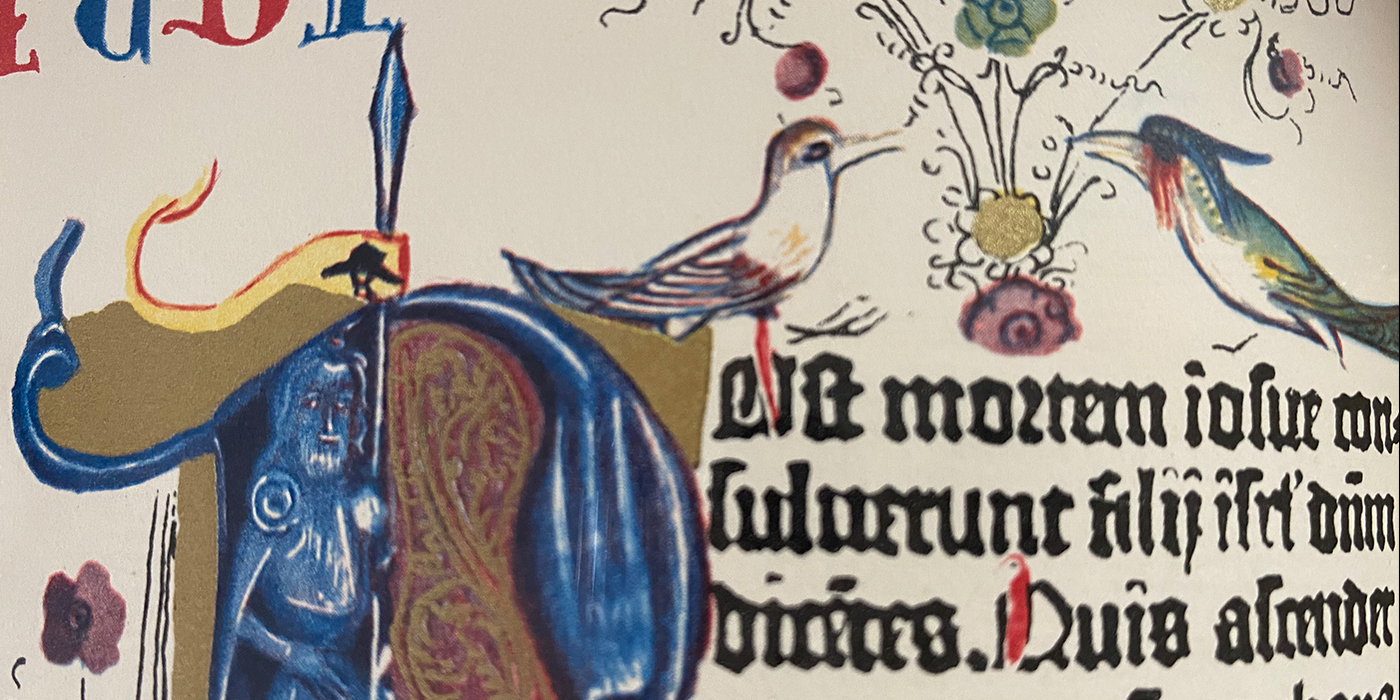
Facsimile of “Gutenberg Bible Detail” by Johann Gutenberg. 5.5” x 6.5” (type based on Textura).
The creation of movable type brought about a revolution that gradually replaced calligraphy with mechanical printing.
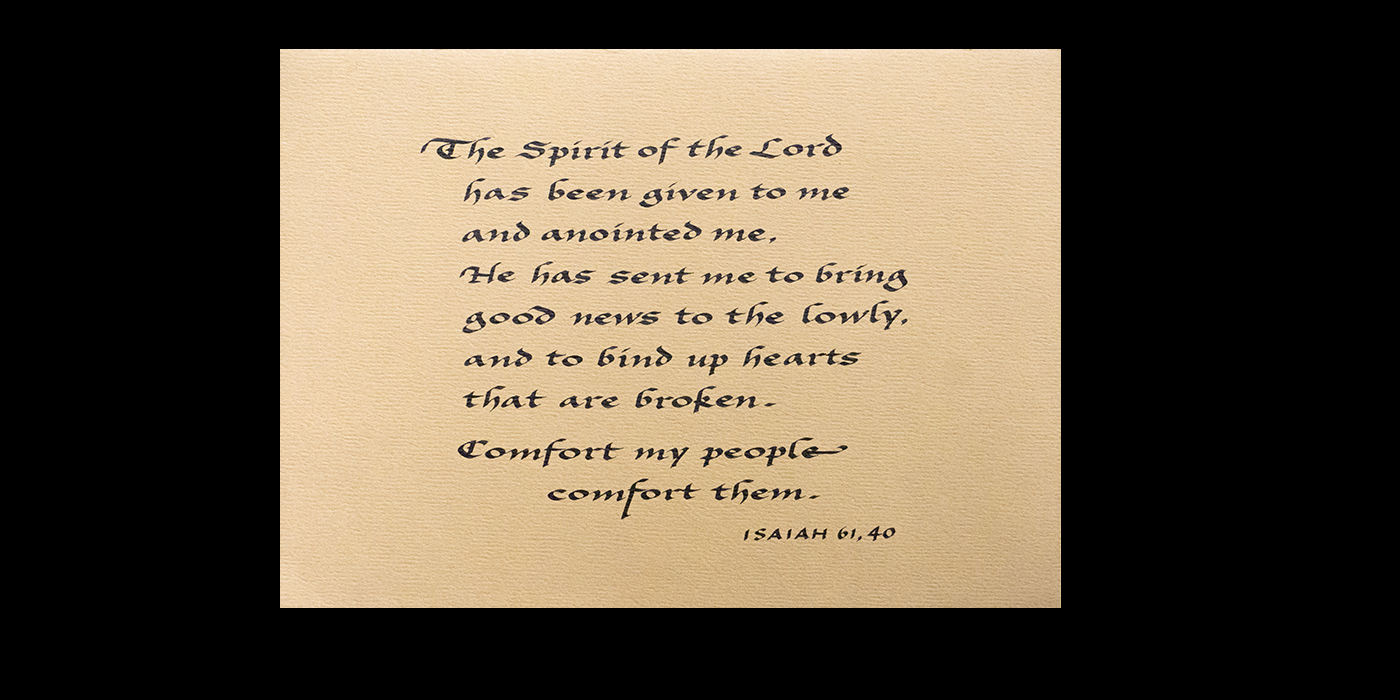
“Isaiah 61, 40” by Fr. Vincent Trujillo, O.S.B. 4.5” x 6.25” (Modern Batarde pen lettering).
By the end of the 19th century, calligraphy began to see a revival. The movement was part of a broader artistic reaction to the mechanization of manual crafts and the so called, Industrial Revolution.
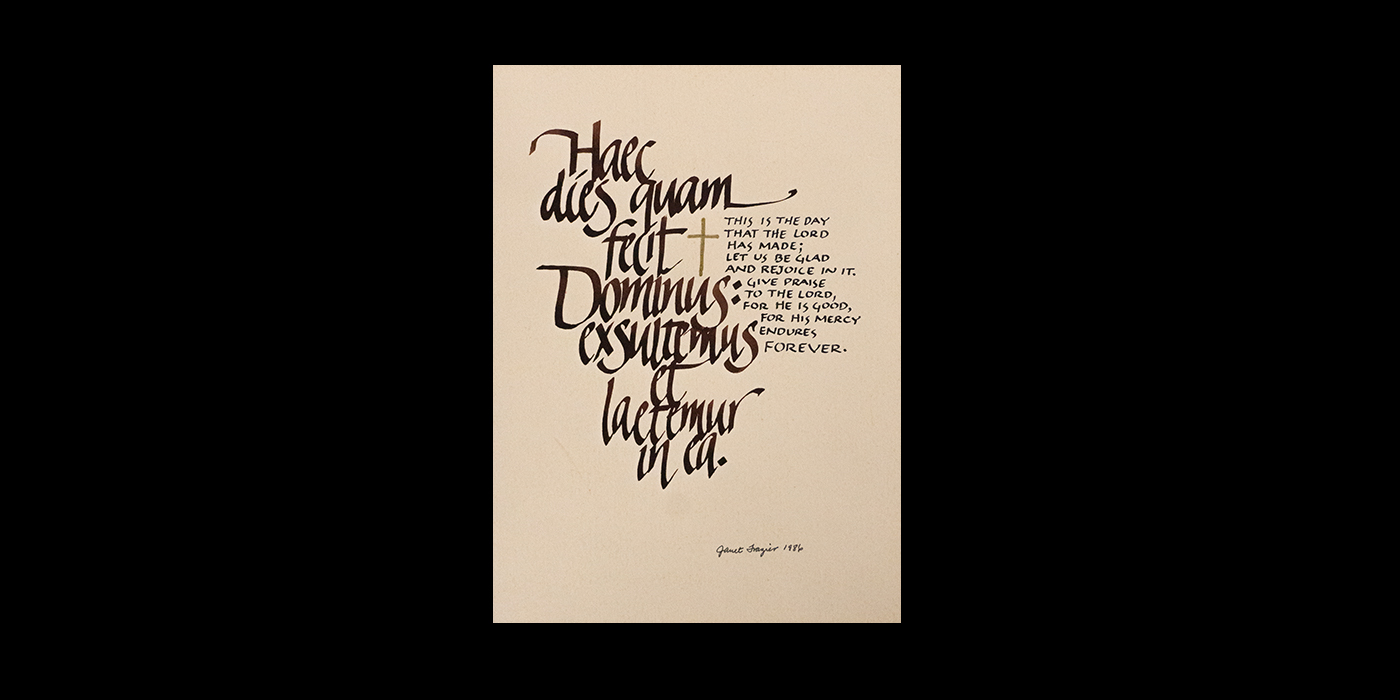
“Psalm 118” 7.5” x 5.5” by Janet Frazier (free form Italic and pen capitals).
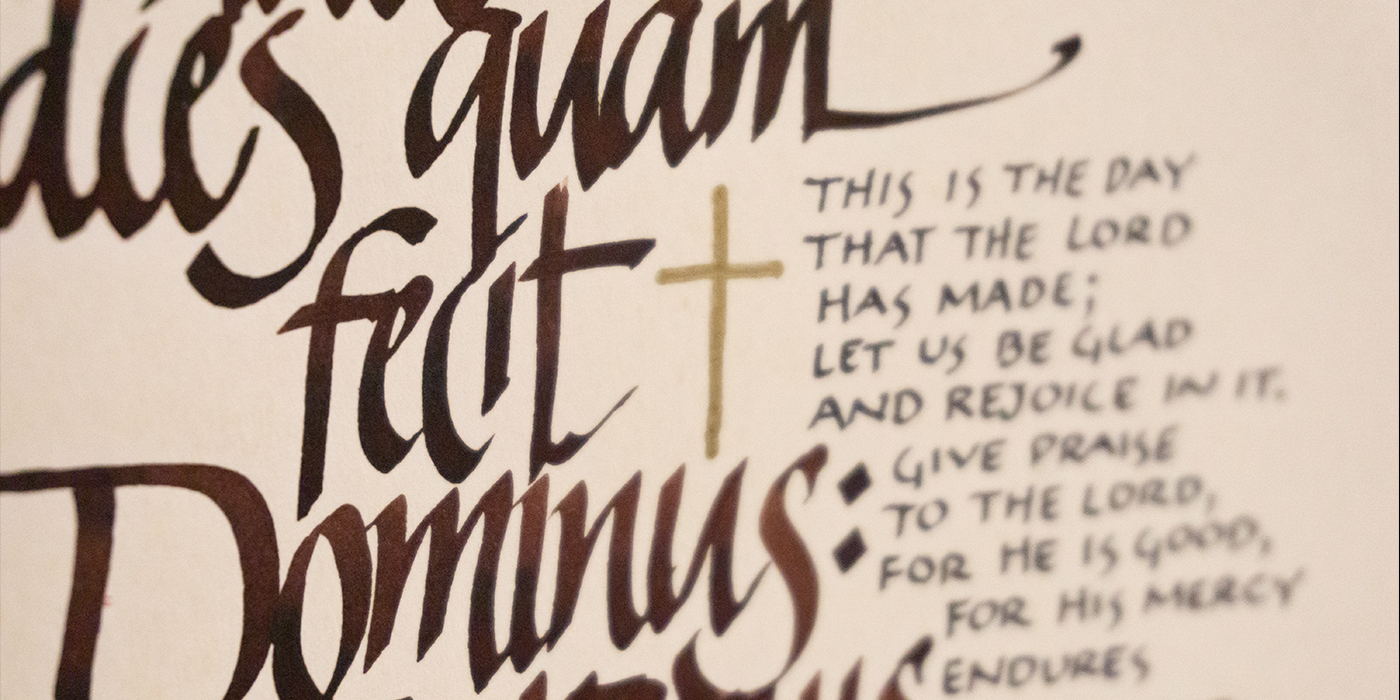
“Psalm 118” detail 7.5” x 5.5” by Janet Frazier (free form Italic and pen capitals).
Pacific Northwest
After World War II American interest in calligraphy also began to spread across the United States. Among the important teachers on the West Coast was Lloyd J. Reynolds (1902-1978).
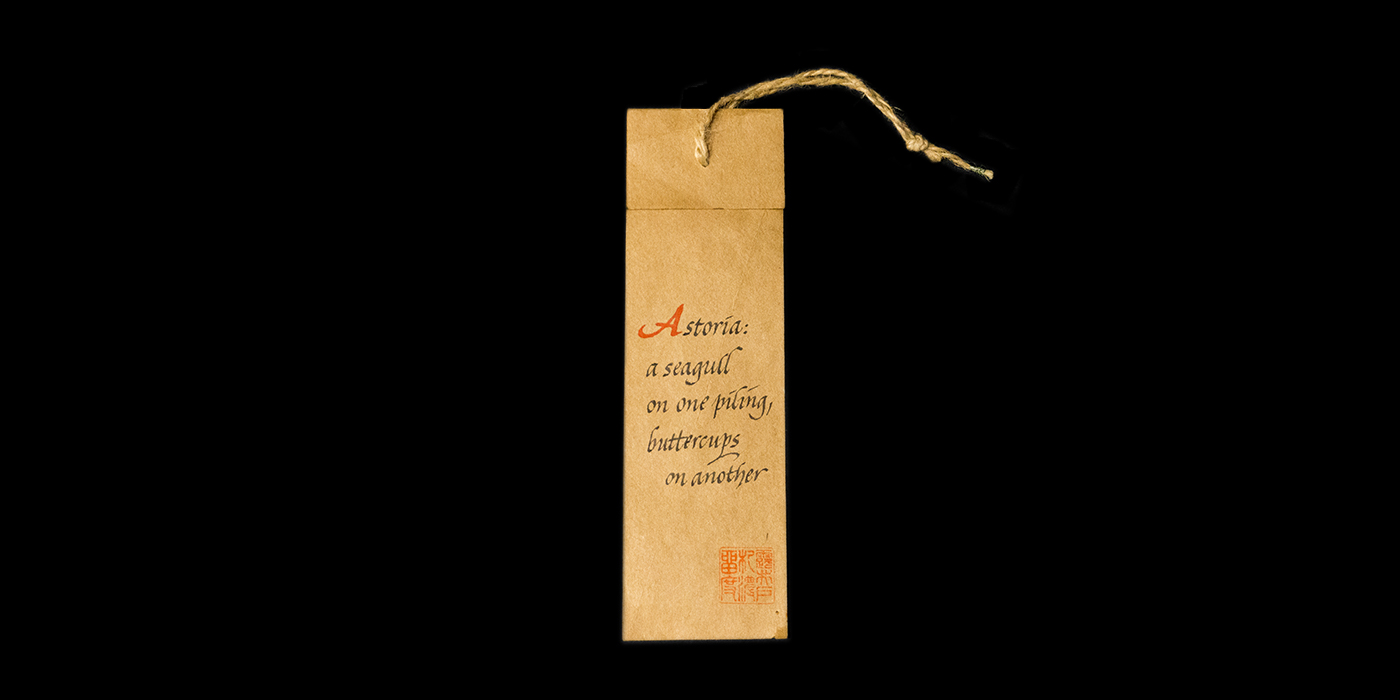
“Weathergram” by Lloyd J. Reynolds. Gift of the artist in 1972 to Fr. Philip Waibel, O.S.B., 8.25” x 2.5” (Italic pen lettering).
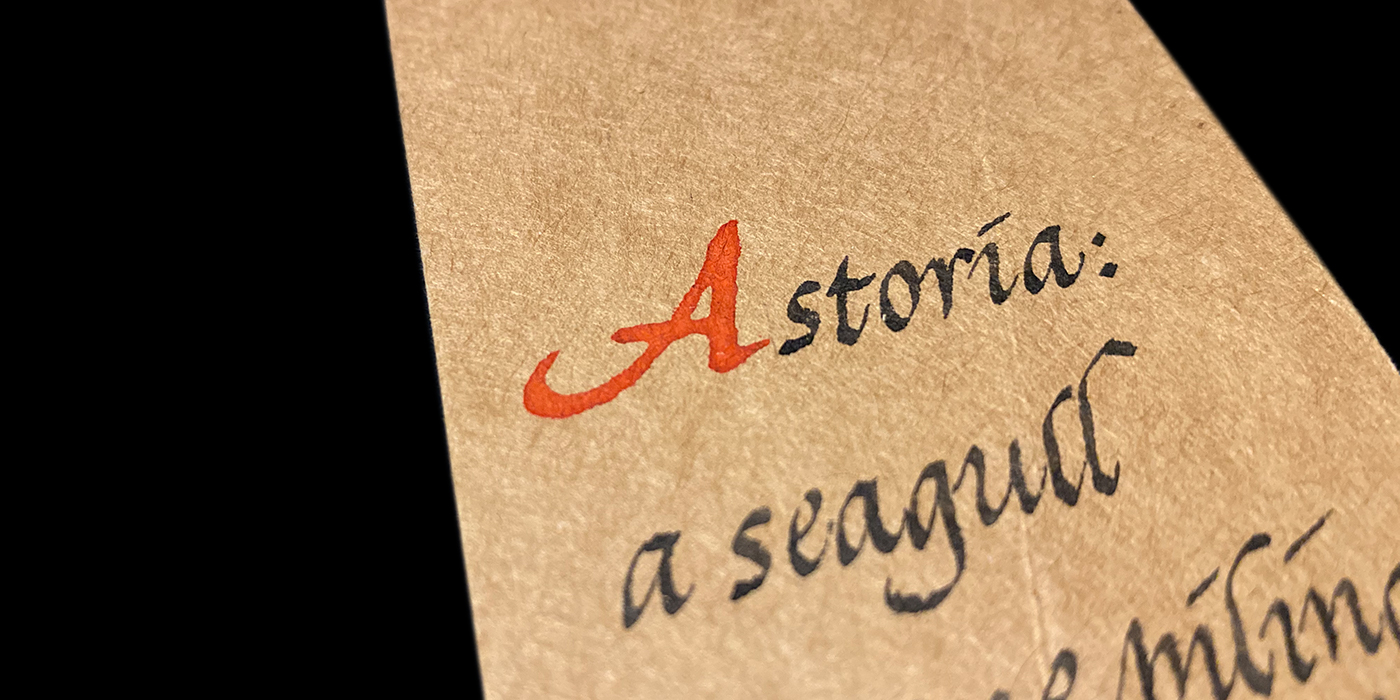
“Weathergram” detail by Lloyd J. Reynolds. Gift of the artist in 1972 to Fr. Philip Waibel, O.S.B., 8.25” x 2.5” (Italic pen lettering).
Reynolds taught italic handwriting to generations of students at Reed College in Portland. His classes were a window on the relationship between visual arts and culture in a very broad sense.
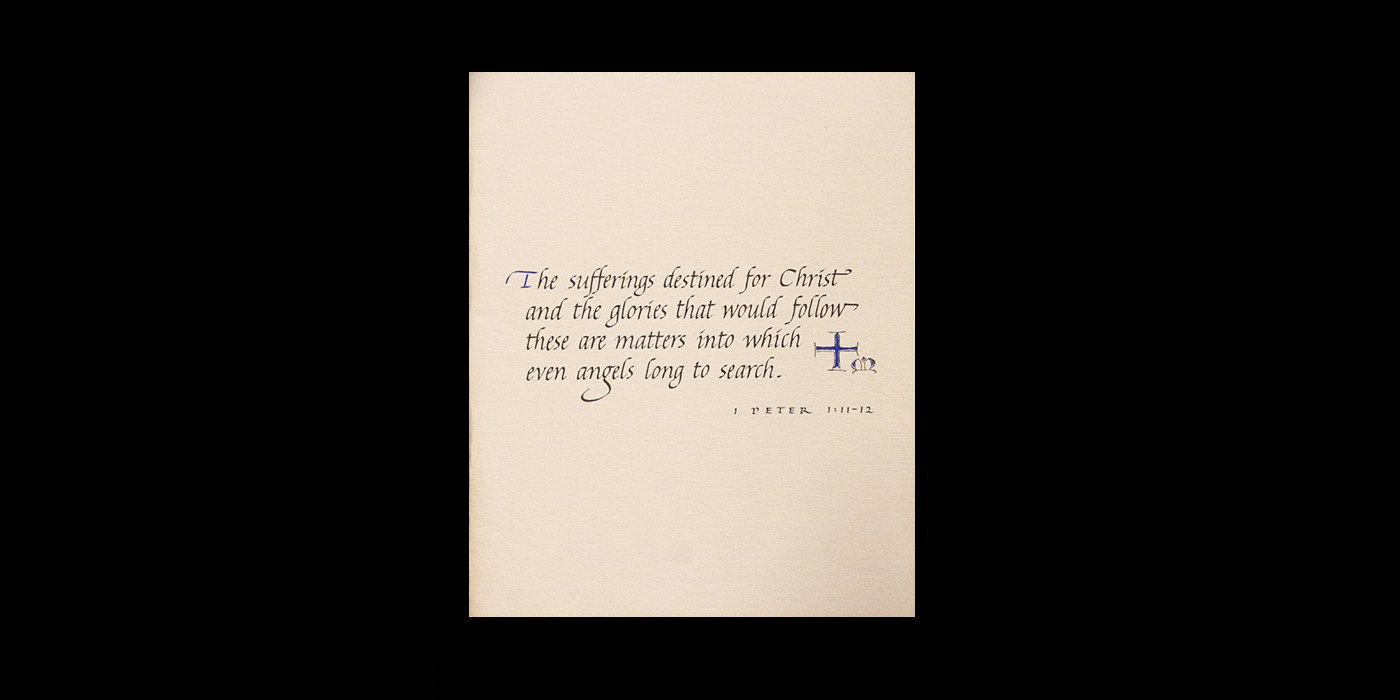
“1 Peter, 1:11-12” by Fr. Vincent Trujillo, O.S.B. 8.25” x 7” (formal Italic lettering).
Fueled by the energy and artistry of Lloyd Reynolds, the “italic hand” flowered and spread throughout the Pacific Northwest.

“How Beautiful are thy Feet and Shoes” by Jaki Svaren. 14” x 17.75” (Italic lettering collage).
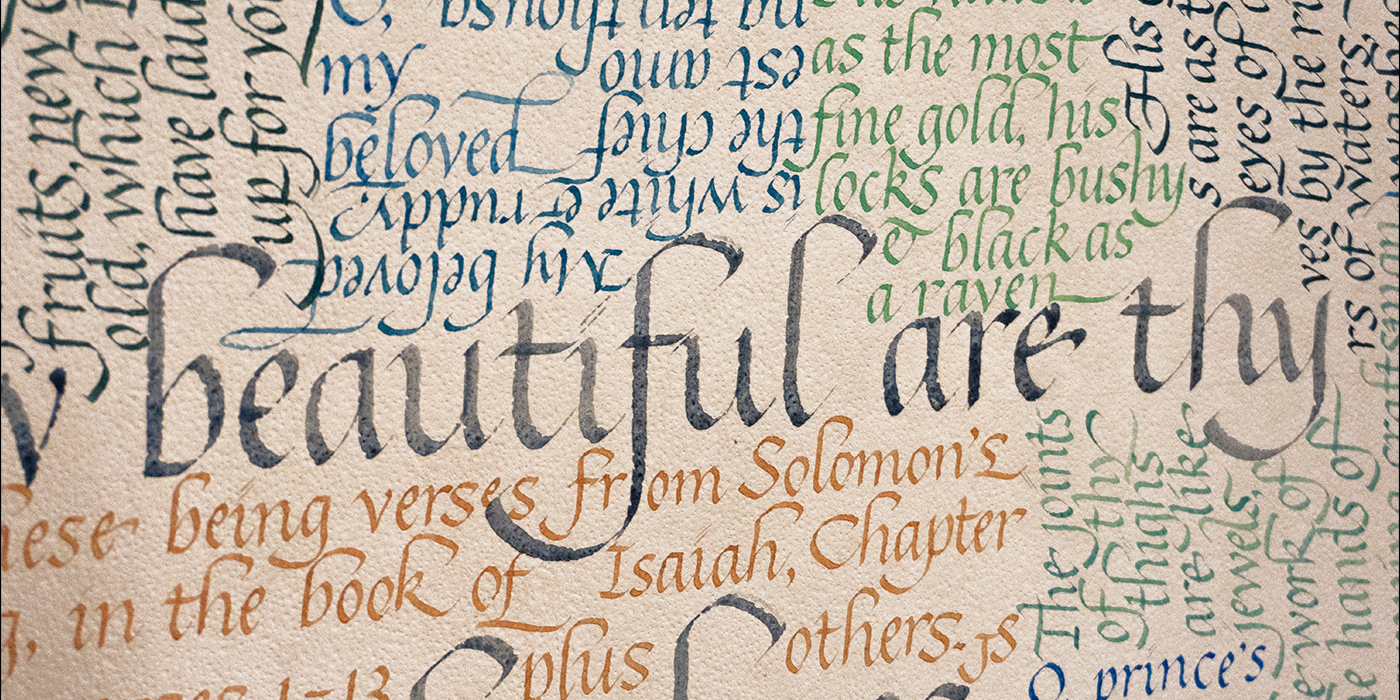
“How Beautiful are thy Feet and Shoes” detail by Jaki Svaren. 14” x 17.75” (Italic lettering collage).
Robert J. Palladino, Lloyd Reynolds’ successor at Reed College, said of him, “His life was a brilliant performance of useful insight.”
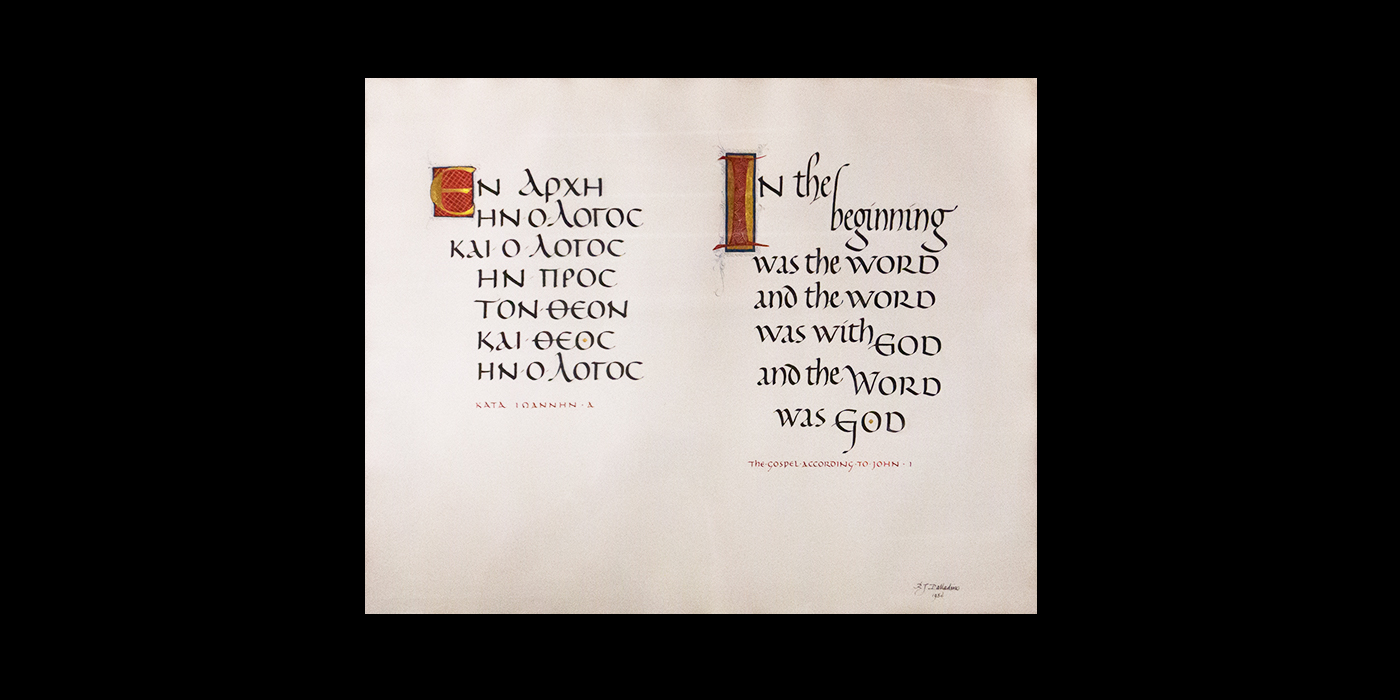
“In the Beginning” by Robert J. Palladino. 18” x 22” (Greek Uncial, Italic lettering, raised gold gouache).
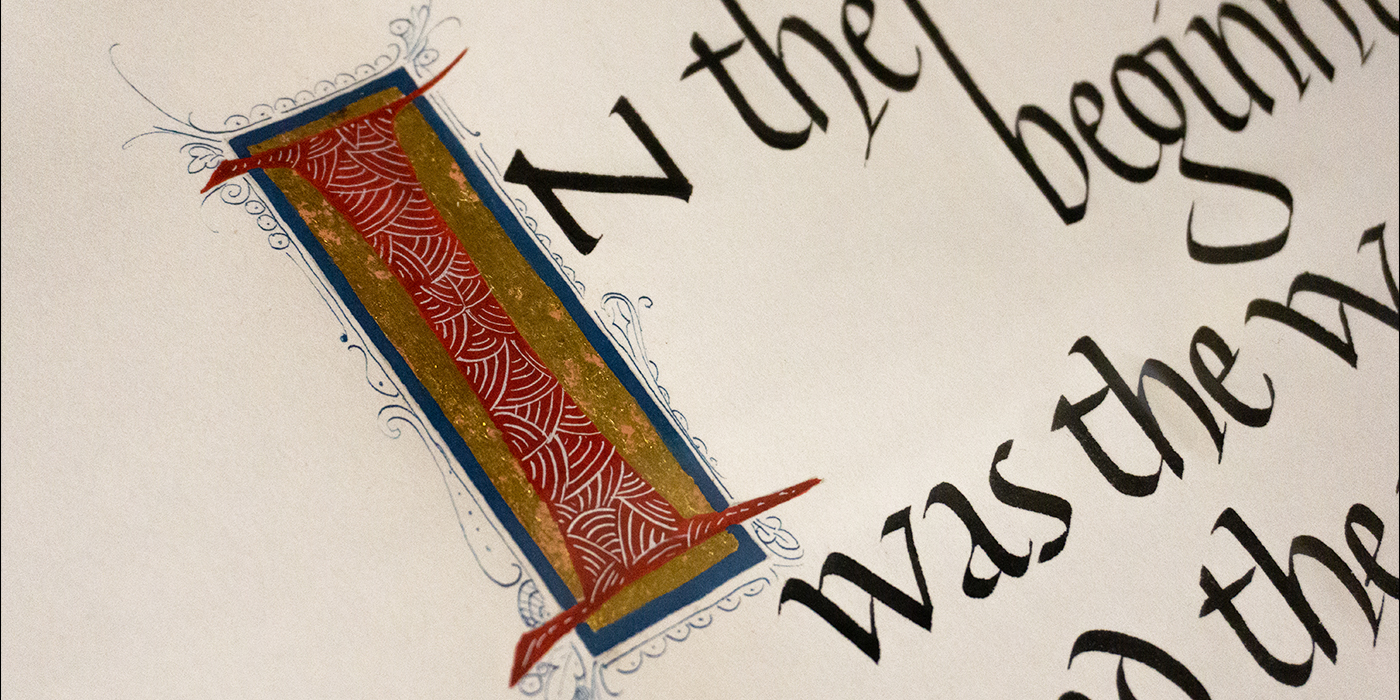
“In the Beginning” detail by Robert J. Palladino. 18” x 22” (Greek Uncial, Italic lettering, raised gold gouache).
Mount Angel Abbey
In the early 1960s, then Br. Vincent Trujillo, O.S.B., was asked if he might be interested in studying calligraphy with Sr. Grace Taylor, O.S.B., from Queen of Angels Monastery in Mt. Angel. Br. Vincent was very interested!
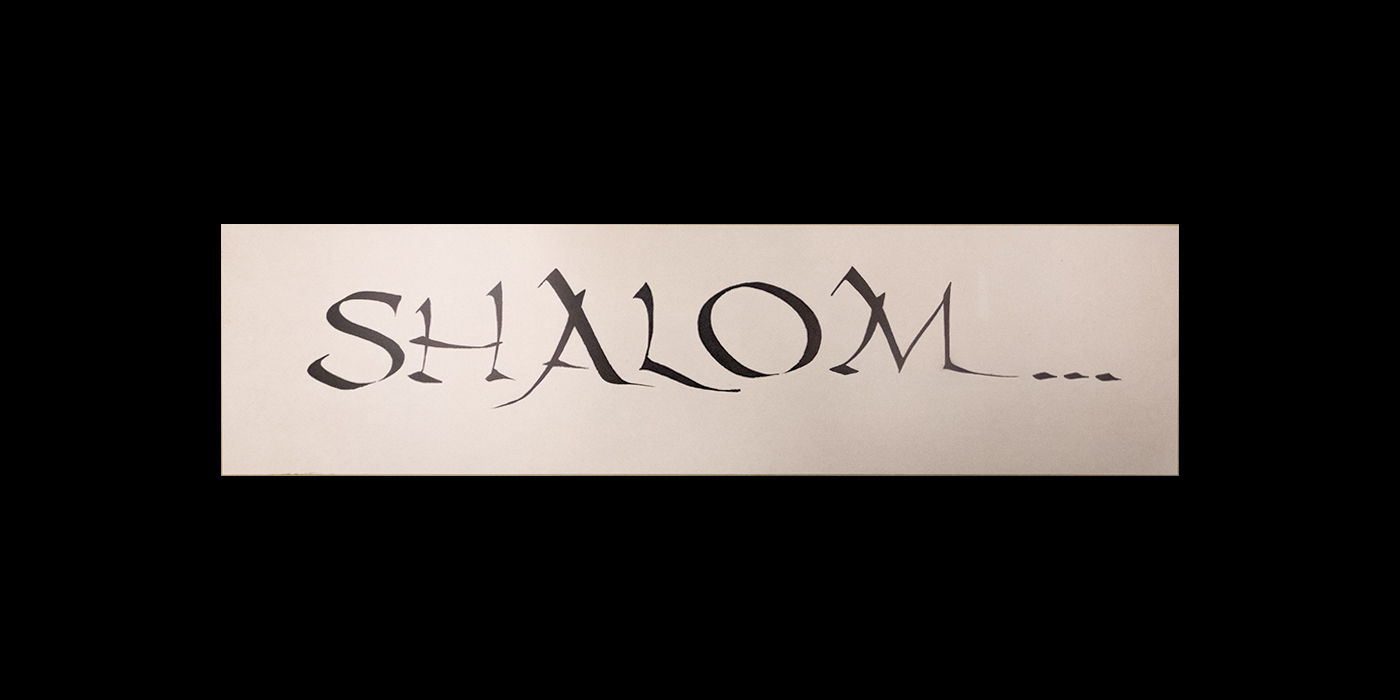
“Shalom” by Fr. Vincent Trujillo, O.S.B. 7” x 24” (rustic lettering)
Sr. Grace Taylor, O.S.B., was Fr. Vincent’s first calligraphy teacher and a devoted student of Lloyd J. Reynolds. She brought all she learned to her own classroom at Mt. Angel College. One of the first recipients of Reed College’s Master of Calligraphy degree, Sr. Grace published a program for calligraphy teachers.
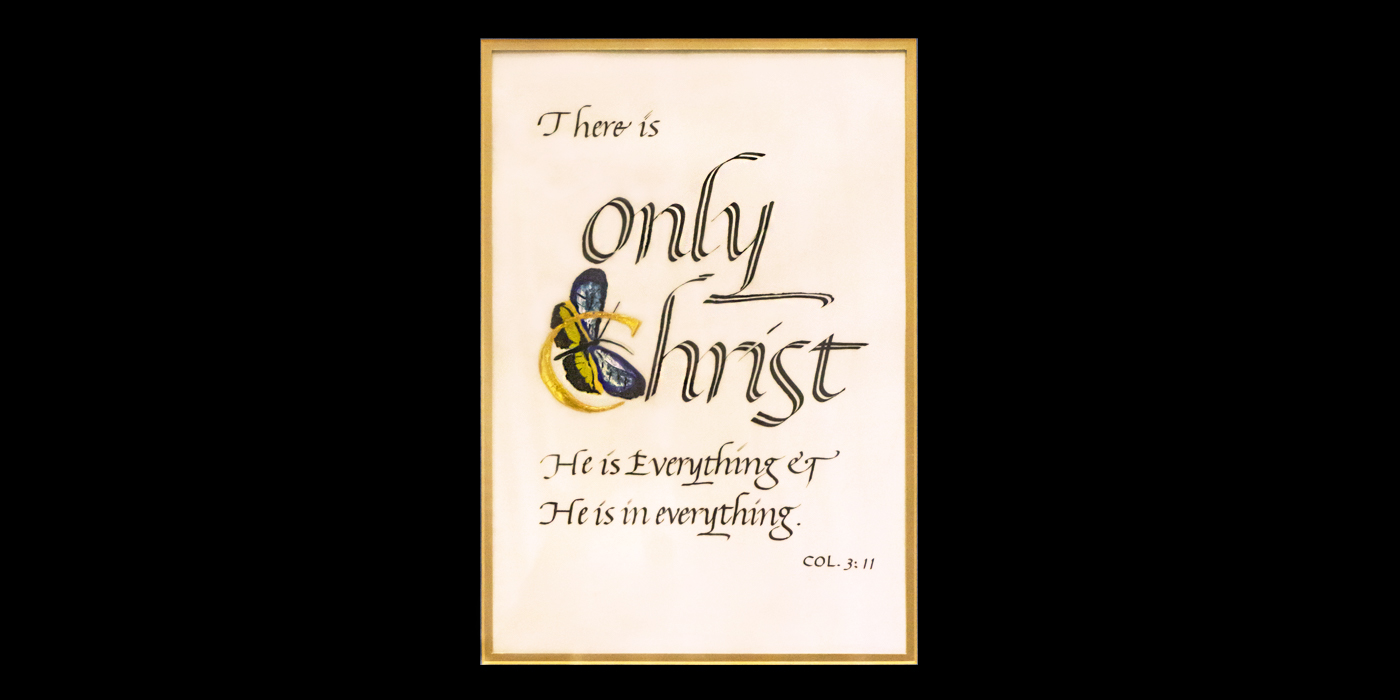
“Only Christ” by Sr. Grace Taylor, O.S.B. 11.5” x 8” From the collection of Queen of Angels Monastery (Formal Italic lettering and raised gilding on vellum)
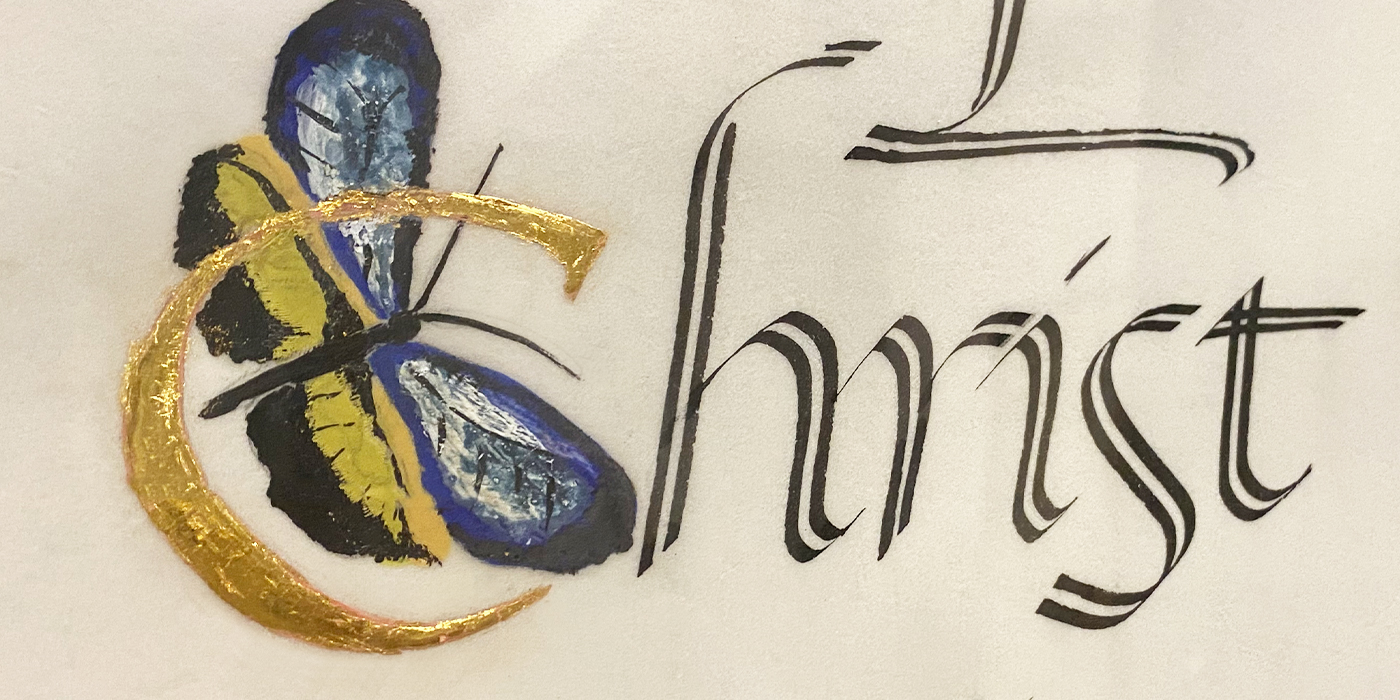
“Only Christ” detail by Sr. Grace Taylor, O.S.B. 11.5” x 8” From the collection of Queen of Angels Monastery (Formal Italic lettering and raised gilding on vellum)
Throughout these years Br. Vincent, later Fr. Vincent, and Sr. Grace, both students of Lloyd Reynolds, raised the appreciation for beautiful handwriting by providing signage, Christmas cards, and invitations, and by teaching many students the art of calligraphy.
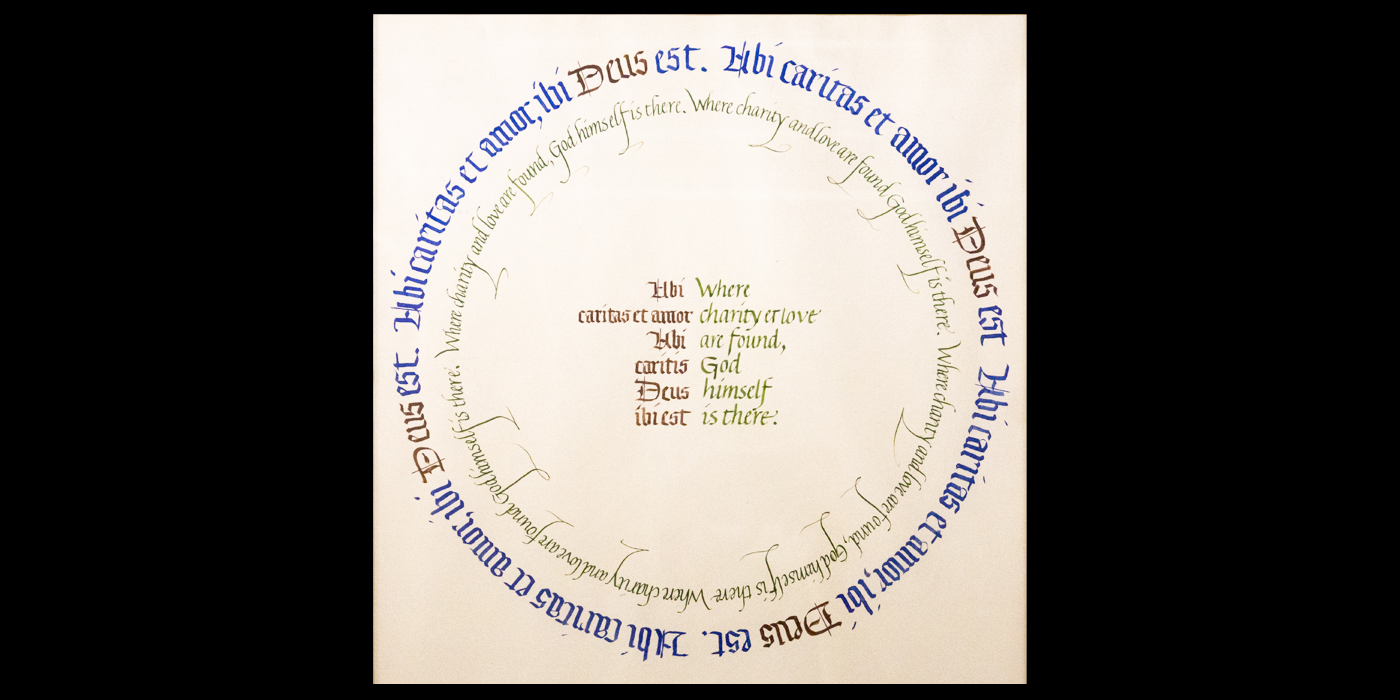
“Where Charity and Love are Found” by Sr. Grace Taylor, O.S.B. 13.75” x 12” from the collection of Queen of Angels Monastery (formal black letter and italic)
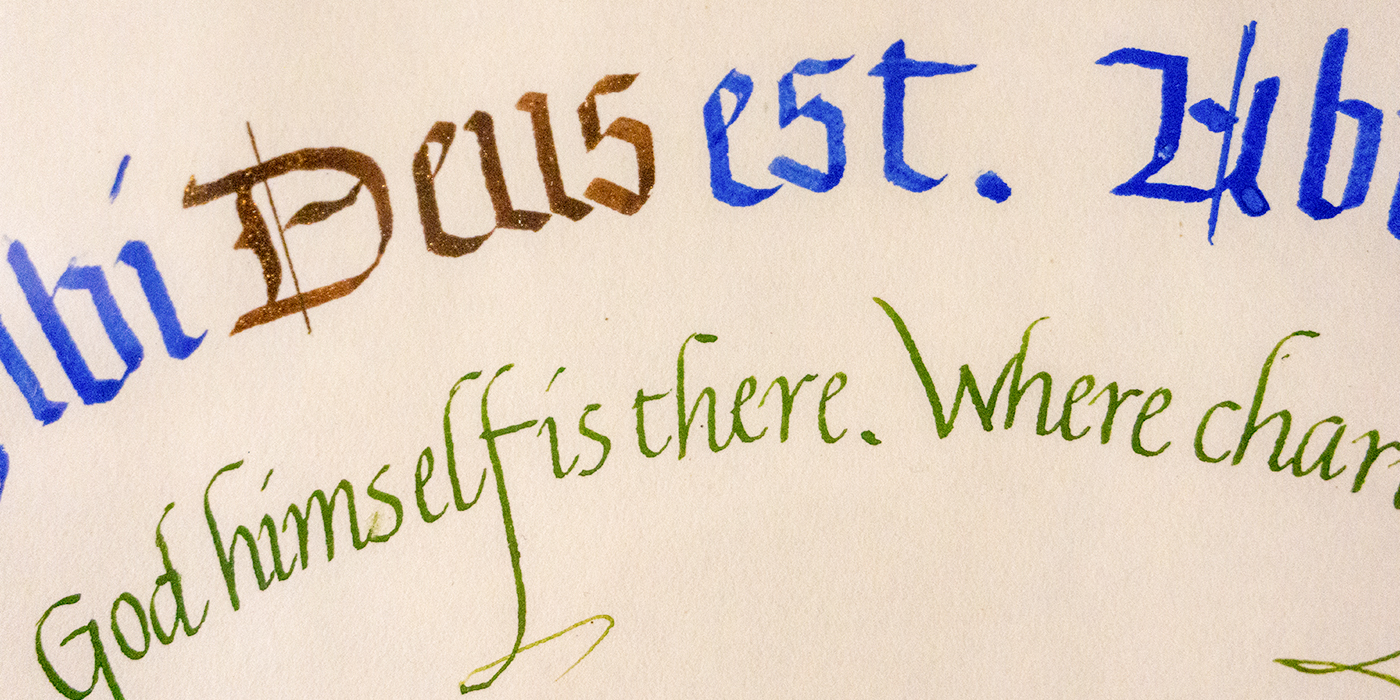
“Where Charity and Love are Found” detail by Sr. Grace Taylor, O.S.B. 13.75” x 12” from the collection of Queen of Angels Monastery (formal black letter and italic)
These touches of beauty highlighted the everyday and the simple, making the common place lyrical. These principles resonated with the earthy spirituality of St. Benedict, finding the beautiful and sacred in the simple.
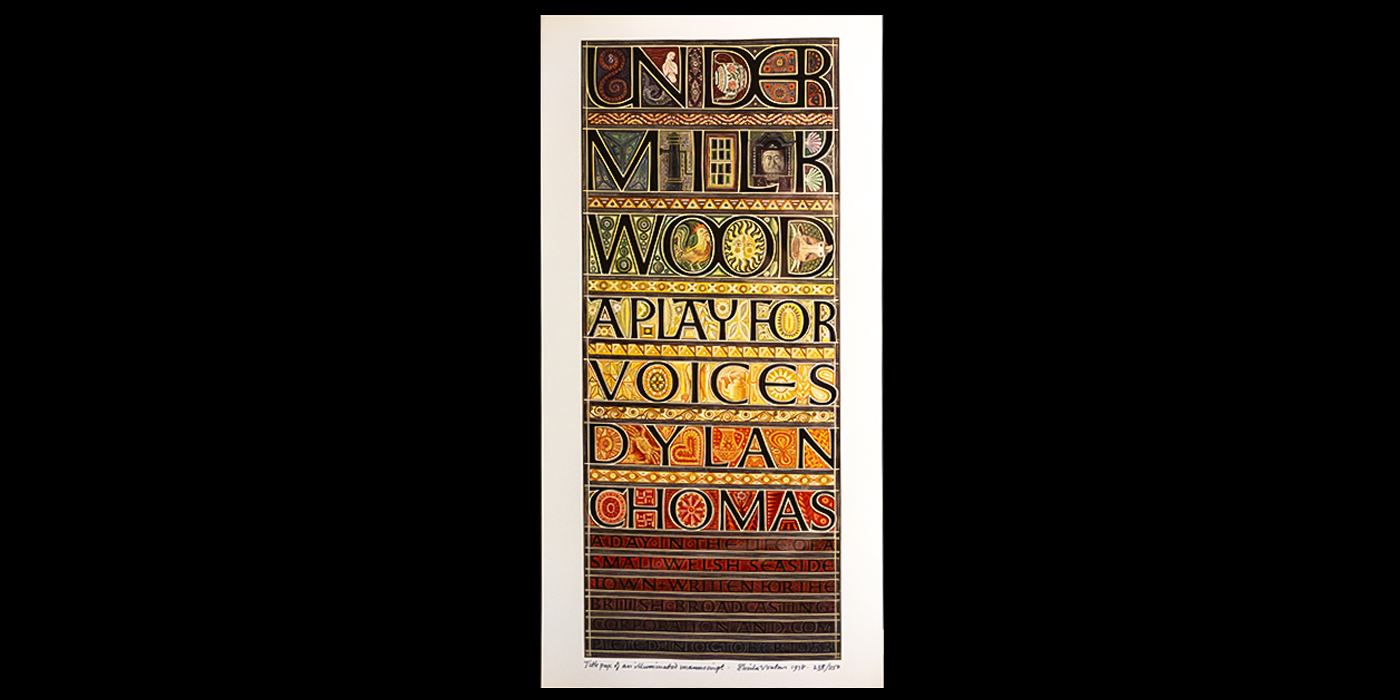
“Under Miller Wood” by Sheila Waters. 11.75” x 4.75” (drawn letters and gouache)
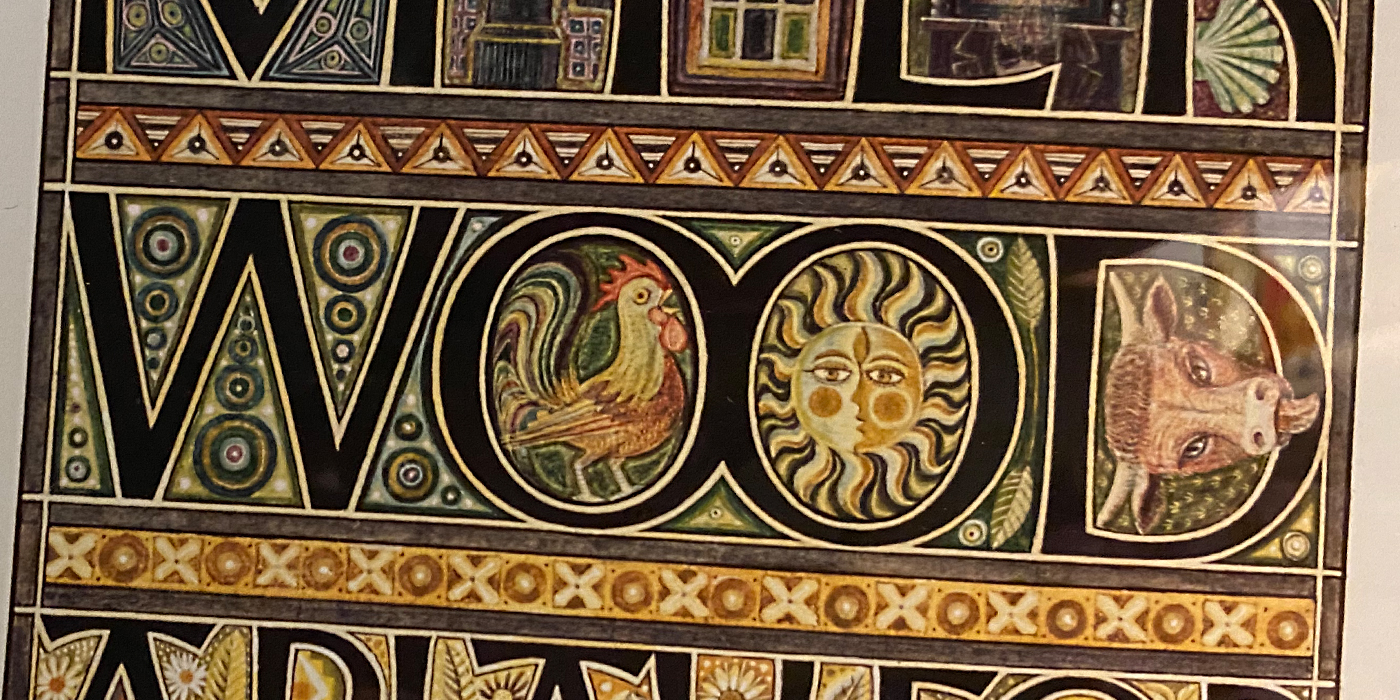
“Under Miller Wood” detail by Sheila Waters. 11.75” x 4.75” (drawn letters and gouache)
In 1973 Mount Angel Seminary took five out of six top prizes for calligraphy in the United States high school competition!
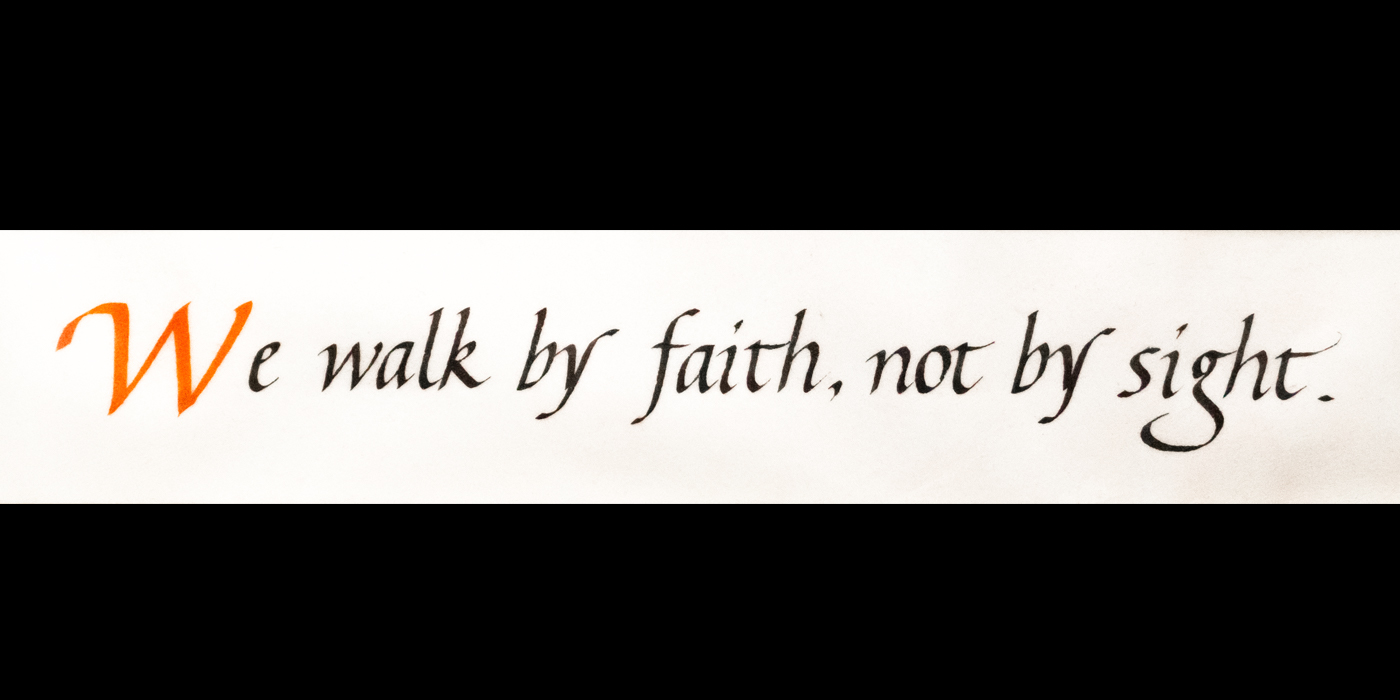
“We Walk by Faith” by Fr. Philip Waibel, O.S.B. 3” x 11” (formal Italic on vellum)
Among Fr. Vincent’s star students was Fr. Philip Waibel, O.S.B., who remains the most productive as well. Fr. Philip developed a strong interest in the history of writing, illuminating and lettering in stone. He admired and learned from the renowned British calligrapher and stonecutter, David Kindersley, who designed and incised the two slate memorials at the Abbey church portico.
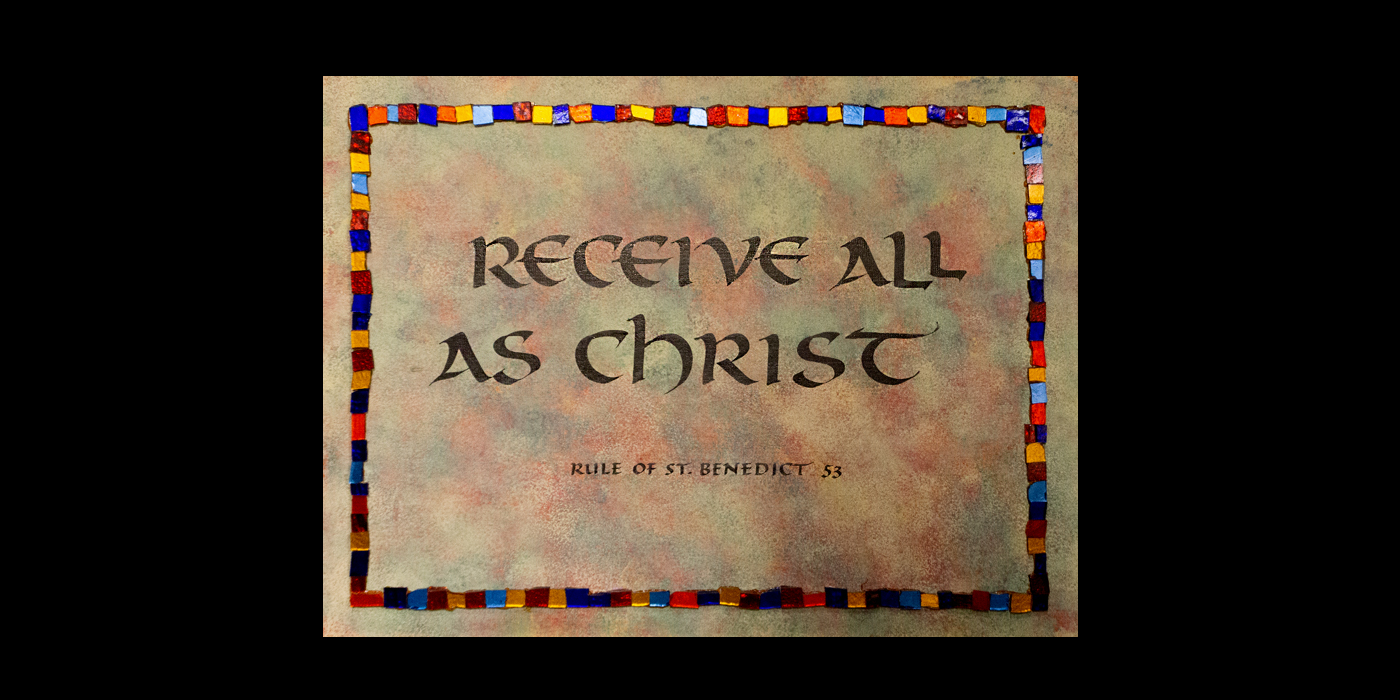
“Receive all as Christ” by Fr. Philip Waibel, O.S.B. 18” x 24” (Uncial Brush on canvas panel with stained glass boarder)
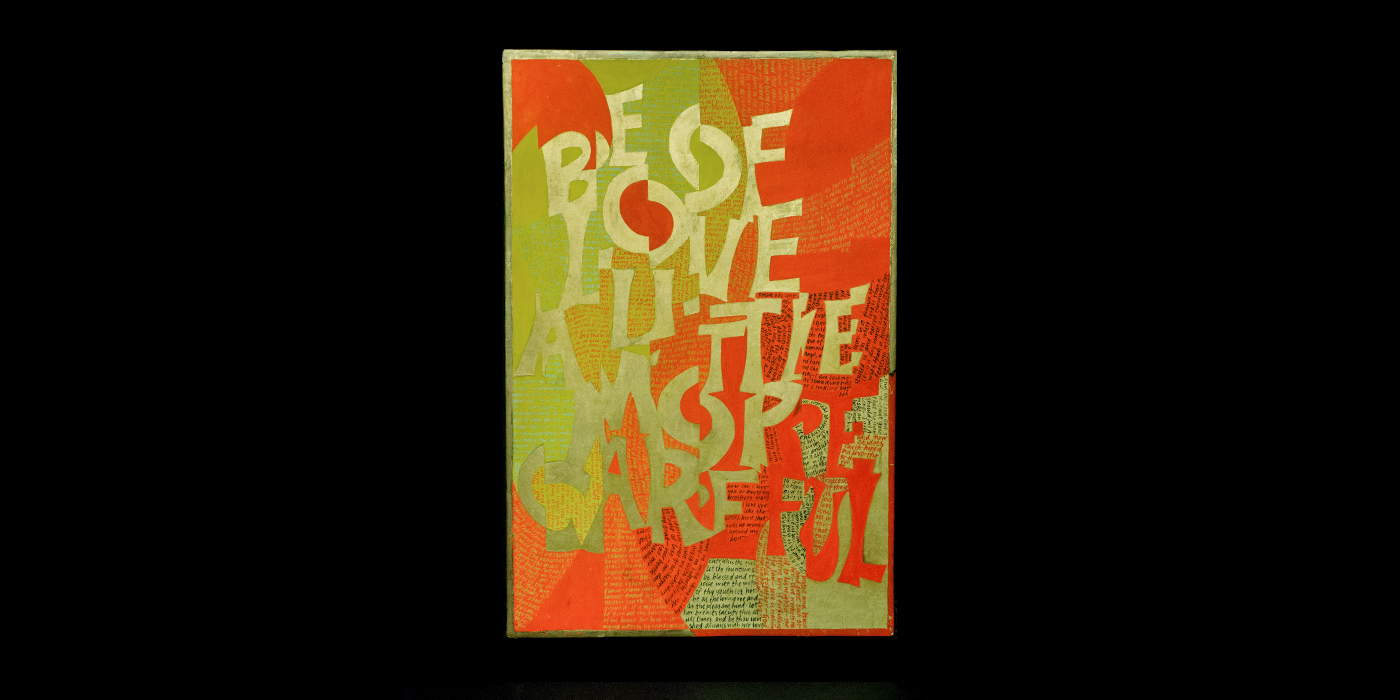
“Be of Love” by Yvonne Bianco. 18” x 12” (23 kt. gold drawn letters with Italic lettering)
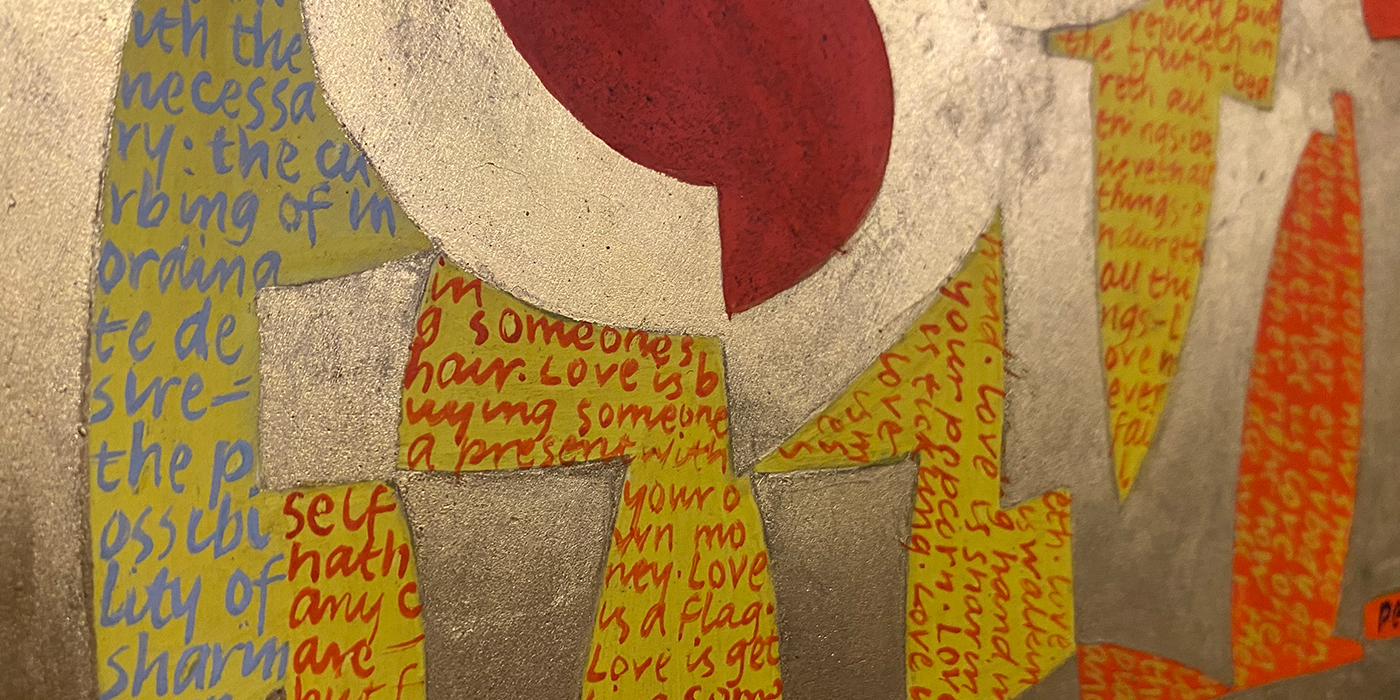
“Be of Love” detail by Yvonne Bianco. 18” x 12” (23 kt. gold drawn letters with Italic lettering).
“Truth, beauty and goodness have their being together; by truth we are put in touch with reality, which we find is good for us and beautiful to behold.”
–Fr. Thomas Dubay (The Evidential Power of Beauty: Science and Theology Meet, Ignatius Press 1999)
Friends, I chose this note because it speaks to me of the all-encompassing presence of God, and because, so often, beauty is overlooked as a true experience of the Divine. – Fr. Nathan Zodrow, O.S.B., Abbey Art Curator
